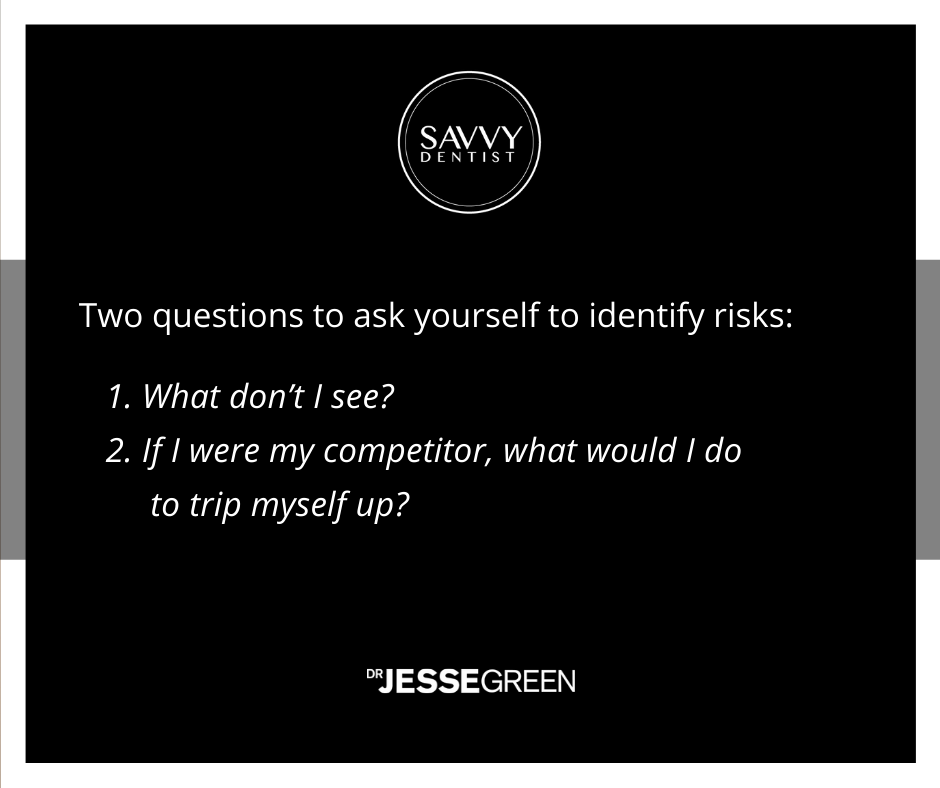Identifying and managing risk is something every practice should do at least once every six months -without exceptions. As the marketplace changes, patient health demographics shift, new regulations pass, and new competition pops up, the risks that affect your practice will constantly be in flux.
Carving out some time twice a year to sit down and target the top five or six risks to your practice allows you to develop contingency plans – which you’ll be very grateful for if the time comes when you have to deploy them.
Today, we’ll provide you with a structure you can use to anticipate and mitigate risks, which will see your practice through any curveballs you may get thrown.
Two questions to help identify risk
The most important question to ask yourself to identify risk is “what don’t I see?”
Our vulnerabilities are often held in blind spots where we’ve made assumptions, perhaps from our own personal values, unchallenged thought processes, habits, unconscious biases, or things that haven’t been updated.
The next question to ask yourself is, “if I was my competitor, what would I do to trip myself up?”
In other words, if I was going to launch a dental practice across the street tomorrow, what would I do to beat the competition? How would I approach that? How would I compete?
This question helps you draw out the ugly bits, the unattractive parts of the business – and that’s where risk is.
You will likely find you have potential risks in a number of categories like personal risk, debt or leverage risks, legal risks, risks around competition and loss of business, risk of fraudulent activity, regulatory risks, and more.
Developing a risk matrix
Once you’ve identified your risks, it’s important to quantify them so we know which ones to target immediately and which ones are less urgent.
The most important thing to determine is, “What’s the likelihood of that particular outcome? Is it likely or unlikely?”
You can also determine the cost associated with each risk. Should this happen, how much will it cost? And cost doesn’t just mean monetary, but could also refer to time, reputation, brand, staffing, or other factors.
Finally, determine the degree of control you have over each risk. If it came to fruition, is it within your power to manage or mitigate the effects?
When I have the answers to these questions for each risk, I plot them on a risk matrix. Here you can determine the severity of each risk from severe to insignificant.
This is a great framework, but it’s also worth considering your tolerance for risk. If there is something that is going to keep you up at night with worry, it needs to be addressed. Everyone will have different thresholds for determining what is an acceptable risk versus what is an unacceptable risk. You need to figure out, “Can I live with the downside?”
Not All Risks Can Be Predicted
This is an unfortunate reality of both life and business. No matter how well prepared you are and whether or not you’ve done your due diligence, sometimes we get thrown things we couldn’t possibly see coming (COVID-19, anyone?).
However, being hit with an unexpected situation isn’t what matters. What matters is how you handle it. If this happens to you, don’t react from a place of emotion, seek outside counsel, and then make a decisive choice. Being thoughtful about your reaction to a negative situation can make all the difference.
When something happens to your business, it can be quite stressful. Make sure to look after yourself and your own wellbeing, check in with your team to ensure they remain engaged, and seek support from the Savvy Dentist resources we publish or from your Practice Max coach if you’re a member.
P.S Want to scale your dental practice and take your profits to 7 figure success?
Me and my team can work with you directly to get you there! Simply book in your FREE 1:1
strategy session, and we can get started on a game plan for you and your practice.




